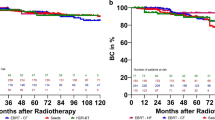Purpose:
To analyze the long-term effect of local dose escalation using conformal hypofractionated high-dose-rate brachytherapy (HDR-BT) boost and pelvic external-beam radiation therapy (EBRT) in hormone-naïve men with localized prostate cancer.
Patients and Methods:
A total of 579 men were consecutively treated with pelvic EBRT and dose escalating HDR-BT since 1986 in two prospective trials: 378 patients at William Beaumont Hospital (1991–2002), and 201 patients at Kiel University (1986–1999). BT optimization was done modulating both, the dwell times and spatial source positions. A short course of neoadjuvant/concurrent androgen deprivation therapy was given to 222 patients. Hormone-naïve patients only (n = 324) with a follow-up ≥ 18 months were analyzed. All patients had at least one poor prognostic factor (stage ≥ T2b, Gleason Score ≥ 7, pretreatment prostate-specific antigen [PSA] ≥ 10 ng/ml): any one factor 122 patients, any two factors 122 patients, and three factors 80 patients. This cohort was stratified by equivalent dose (ED): dose level 1, ≤ 94 Gy, n = 58, and dose level 2, > 94 Gy, n = 266, assuming an α/β ratio of 1.2. The ASTRO definition for biochemical failure was used.
Results:
Mean follow-up was 5.3 years (1.5–13.9 years). For all 324 patients, the 5-year biochemical control (BC) rate was 79%. Cancer-specific survival was 98%, and overall survival 90%. Similar analysis by institution demonstrated no difference in outcomes. For the entire cohort of hormone-naïve men, dose escalation to > 94 Gy resulted in a better 5-year BC of 59% versus 85% (p < 0.001). Discriminating by risk group a striking dose escalation effect was seen in the groups with two or three poor prognostic factors (p = 0.022 and < 0.001, respectively). In the group with only one poor prognostic factor, no statistical difference could be detected questioning the need for ED > 94 Gy.
Conclusion:
The results demonstrate that conformal HDR-BT is a successful method for delivering very high radiation dose to the prostate. The ability to escalate dose to ED > 94 Gy was reflected in improved long-term outcomes in terms of BC, significantly for those patients with two or three poor prognostic factors reaching BC rates of 85%.
Ziel:
Der Langzeiteffekt der lokalen Dosiseskalation mit Hilfe der konformalen, hypofraktionierten High-Dose-Rate-Brachytherapie (HDR-BT) und der pelvinen perkutanen Strahlentherapie bei hormonnaiven Patienten mit lokalisiertem Prostatakarzinom wird untersucht.
Patienten und Methodik:
Insgesamt wurden 579 Patienten mit pelviner Teletherapie und dosiseskalierender HDR-BT seit 1986 in zwei prospektiven Studien behandelt: 378 Patienten im William-Beaumont-Hospital (1991–2002) und 201 Patienten im Kieler Universitätsklinikum (1986–1999). Die BT-Optimierung wurde durch Modellierung der Verweildauer bzw. der räumlichen Quellenpositionen vorgenommen. Eine kurzzeitige neoadjuvante/simultane Androgendeprivation wurde bei 222 Patienten durchgeführt. Nur die hormonnaiven Patienten (n = 324) mit einem Nachbeobachtungszeitraum ≥ 18 Monate wurden analysiert. Alle Patienten hatten zumindest einen negativen prognostischen Faktor (Stadium ≥ T2b, Gleason-Score ≥ 7, prätherapeutisches prostataspezifisches Antigen [PSA] ≥ 10 ng/ml): 122 Patienten einen Faktor, 122 Patienten zwei Faktoren und 80 Patienten drei Faktoren. Diese Stichprobe wurde nach Äquivalentdosis (ED) stratifiziert: Dosislevel 1 ≤ 94 Gy, n = 58, und Dosislevel 2, > 94 Gy, n = 266, mit der Annahme einer α/β-Ratio von 1,2. Die ASTRO-Definition für biochemisches Versagen wurde verwendet.
Ergebnisse:
Der durchschnittliche Nachbeobachtungszeitraum lag bei 5,3 Jahren (1,5–13,9 Jahre). Die biochemische 5-Jahres-Kontroll-(BC-)Rate betrug für alle 324 Patienten 79%, die krebsspezifische Überlebensrate 98% und die Gesamtüberlebensrate 90%. Eine Überlebensdifferenz zwischen den Institutionen wurde nicht nachgewiesen. Die Dosiseskalation auf > 94 Gy ergab für die gesamte hormonnaive Population eine verbesserte 5-Jahres-BC-Rate von 59% versus 85% (p < 0,001). In den Patientengruppen mit zwei bis drei Risikofaktoren wurde ein substantieller Dosiseskalationseffekt gesehen (p = 0,022 bzw. < 0,001). In der Patientengruppe mit nur einem Risikofaktor konnte keine statistisch signifikante Differenz detektiert werden, so dass die Notwendigkeit einer ED > 94 Gy in Frage gestellt wird.
Schlussfolgerung:
Die Ergebnisse belegen, dass die konformale HDR-BT eine erfolgreiche Methode der Dosiseskalation in der Prostata ist. Die Eskalation der ED auf > 94 Gy führte zu verbesserten Langzeitergebnissen in der BC von 85% bei Patienten mit zwei bis drei Risikofaktoren.
Similar content being viewed by others
Author information
Authors and Affiliations
Corresponding author
Rights and permissions
About this article
Cite this article
Galalae, R.M., Martinez, A., Nuernberg, N. et al. Hypofractionated Conformal HDR Brachytherapy in Hormone Naïve Men with Localized Prostate Cancer. Strahlenther Onkol 182, 135–141 (2006). https://doi.org/10.1007/s00066-006-1448-5
Received:
Revised:
Issue Date:
DOI: https://doi.org/10.1007/s00066-006-1448-5




